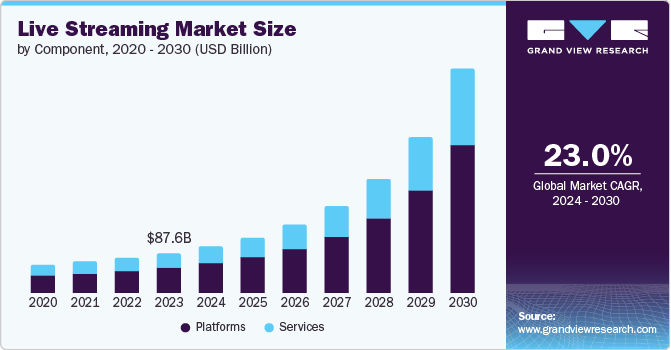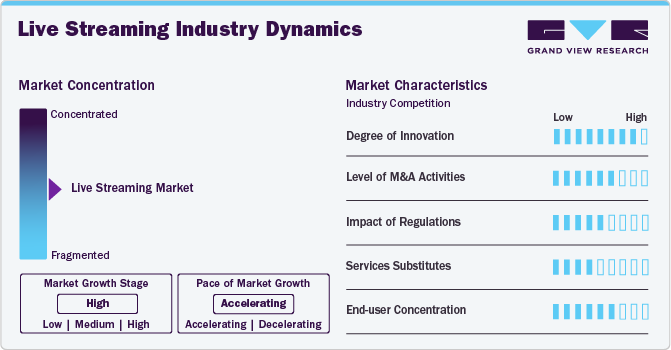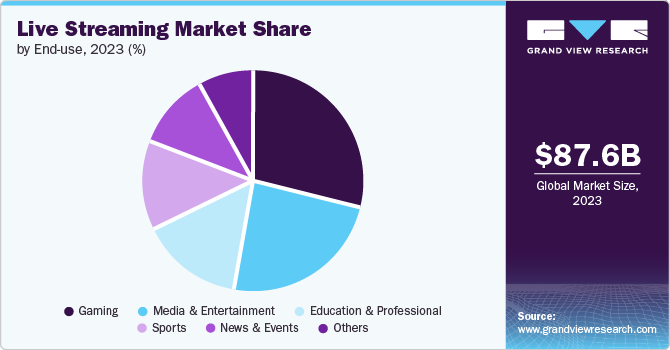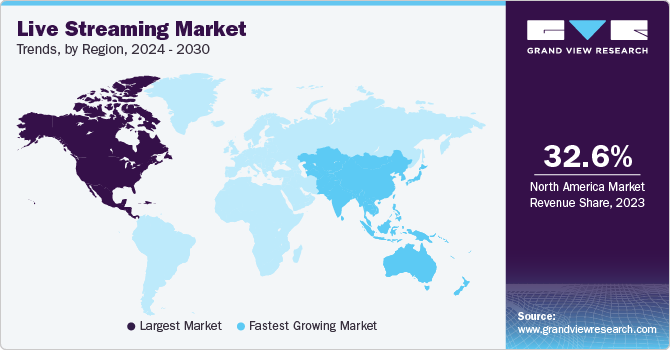
Live Streaming Market Size, Share & Trend Analysis Report By Component (Platforms, Services), By Type (Audio Streaming, Video Streaming), By Revenue Model, By End-use, By Region, And Segment Forecasts, 2024 - 2030
- Report ID: GVR-4-68040-326-2
- Number of Report Pages: 150
- Format: PDF
- Historical Range: 2017 - 2022
- Forecast Period: 2024 - 2030
- Industry: Technology
Live Streaming Market Size & Trends
The global live streaming market size was estimated at USD 87.55 billion in 2023 and is projected to grow at a CAGR of 23.0% from 2024 to 2030. The business world is experiencing a dramatic shift in how audiences consume content. Viewers are no longer satisfied with passively watching pre-recorded media. They crave a more interactive experience, wanting to engage directly with the content. Live streaming has emerged as a powerful tool to address this demand. Live Q&A sessions with influencers or experts on platforms such as Instagram Live or YouTube Live allow audiences to engage with personalities they admire directly, asking questions and receiving responses at the moment. It provides a platform for viewers to actively participate in real-time.

This real-time interaction transforms content consumption from a passive activity into an immersive and engaging experience. Ultimately, live streaming strengthens the connection between brands and their audiences by fostering a more interactive and dynamic relationship.
Viewers consume content across various platforms and devices, such as smartphones, tablets, smart TVs, and gaming consoles. This flexibility enables them to access their preferred content anytime and anywhere, enhancing convenience and supporting their on-the-go lifestyles. As a result, users can seamlessly transition between devices, ensuring uninterrupted viewing experiences and maximizing engagement with their favorite content. Content creators benefit from this trend by reaching wider audiences and providing accessible content tailored to different viewing habits. Ultimately, multi-platform consumption represents a paradigm shift in how audiences interact with media. It offers viewers greater flexibility and convenience in their content consumption habits while presenting new opportunities for content creators to innovate and engage with their audience across diverse platforms. For instance, Netflix, a U.S.-based streaming media company, embraced multi-platform consumption, offering content across smartphones, tablets, smart TVs, gaming consoles, and computers for on-the-go viewing convenience.
Emerging technologies such as virtual reality (VR), augmented reality (AR), and mixed reality (MR) are propelling the market forward by enhancing the immersive experience for viewers. These technologies enable live streamers to create more interactive and engaging content by incorporating virtual elements into their broadcasts. VR live streaming allows viewers to feel like they are part of the event or environment being streamed, while AR overlays provide additional information or interactive elements in real-time. As these technologies become more accessible and widely adopted, they open up new possibilities for content creators to captivate audiences and differentiate their live streams in an increasingly competitive market.
Industry Dynamics
The degree of innovation in the market is high, marked by continuous advancements in technology, content creation, and audience engagement strategies. From the integration of augmented reality and virtual reality to enhance immersive experiences to the development of sophisticated analytics tools for personalized content recommendations, innovation permeates every aspect of the live-streaming ecosystem. Content creators are exploring new formats and genres, experimenting with interactive features and collaborative platforms to captivate audiences in novel ways. Moreover, brands are utilizing live streaming for innovative marketing campaigns, product launches, and customer interactions, pushing the boundaries of traditional advertising. With ongoing investments in research and development, the live streaming industry is poised for further innovation.
The live streaming industry has been experiencing a notable level of merger and acquisition (M&A) activity. Many large technology and media companies have been acquiring or investing in live streaming platforms to capitalize on the growing demand for live content consumption. Moreover, there have been instances of consolidation within the industry as smaller players merge to strengthen their market position and expand their offerings. These M&A activities are driven by various factors, including the desire to access new audiences, acquire innovative technologies, and establish dominance in the increasingly competitive live streaming landscape.

Regulation exerts a profound influence on the live streaming industry, affecting various facets of platform operations and user interactions. Content moderation regulations compel platforms to implement stringent measures to mitigate the dissemination of harmful or illegal content, impacting both user experience and operational costs. Copyright enforcement regulations compel platforms to address copyright infringement issues, requiring the implementation of content identification technologies and licensing agreements with rights holders. Consequently, navigating regulatory landscapes while balancing user interests and legal obligations is paramount for live streaming platforms to sustain growth and ensure compliance.
While substitutes such as social media live streaming and video conferencing platforms may attract users seeking alternative ways to engage with live content, they also introduce competition for traditional live streaming platforms. This competition can drive innovation and differentiation as platforms strive to retain and attract users through unique features, content offerings, and user experiences. In addition, service substitutes may expand the overall reach and accessibility of live streaming by catering to specific use cases or target audiences not fully served by traditional platforms.
Major platforms such as Twitch, YouTube Live, Facebook Gaming, and platforms owned by Chinese tech giants dominate the market, attracting millions of users worldwide. However, despite the presence of these major players, there is still room for niche platforms catering to specific interests or demographics. However, emerging technologies and market trends could disrupt the current landscape, leading to shifts in end user concentration over time. As competition intensifies and user preferences evolve, platforms must innovate and differentiate themselves to attract and retain users, ensuring a dynamic and competitive marketplace for live streaming services.
Component Insights
The platforms segment led the market and accounted for 64.03% of the global revenue in 2023. The platforms segment is expanding rapidly, driven by factors such as evolving user preferences, technological advancements, and the diversification of content offerings. Major platforms such as Twitch, YouTube Live, and Facebook Gaming continue to dominate the market, attracting millions of users with their diverse range of content and robust features for creators and viewers alike. However, the market is witnessing the emergence of niche platforms that serve specific interests or demographics, such as gaming-focused platforms like Steam Live and Xbox Live, educational platforms, and professional networking platforms like LinkedIn Live. Moreover, social media platforms such as Instagram, Twitter, and TikTok are integrating live streaming features, further expanding the sector and providing new avenues for content creators to engage with their audiences.
The services segment is projected to grow significantly over the forecast period. The services segment is experiencing notable growth, propelled by the increasing demand for specialized services that cater to the diverse needs of content creators, brands, and viewers. Service providers are offering a wide range of solutions, including content creation tools, streaming software, analytics platforms, monetization services, and audience engagement tools. These services empower content creators to produce high-quality live streams, optimize their content strategy, and effectively monetize their audience base. Moreover, brands and businesses are utilizing live streaming services for marketing campaigns, product launches, and customer engagement initiatives, driving further demand for tailored solutions. As the market continues to expand, service providers are innovating and diversifying their offerings to address evolving industry trends and serve the growing needs of users across various verticals and platforms.
Type Insights
The video streaming segment accounted for the largest market revenue share in 2023. With the proliferation of high-speed internet and the widespread availability of affordable data plans, more people around the world have access to live video streaming services. This increased connectivity has expanded the potential audience for live streaming platforms. Over-the-top streaming platforms, which deliver live video content over the internet without the need for traditional cable or satellite subscriptions, have become increasingly popular. Services such as Twitch, YouTube Live, Facebook Live, and others offer a vast array of live streams, including gaming, sports, events, and more, attracting viewers globally.
The audio streaming segment will witness significant growth in the coming years. The surge in podcasting popularity has propelled the demand for platforms offering live audio streaming capabilities. Podcasters are increasingly turning to live streaming to engage with their audience in real time, enhancing listener interaction and fostering a sense of community. Moreover, the accessibility and convenience of live audio streaming appeal to users with limited internet bandwidth or those seeking an alternative to video content. Moreover, live audio streaming presents monetization opportunities for creators through sponsorships, donations, and advertising, incentivizing content production and platform engagement.
Revenue Model Insights
The Ad-Supported segment accounted for the largest market revenue share in 2023. Ad-supported models dominate the market primarily due to their accessibility and affordability, offering free access to content for viewers, which attracts a broad audience base. This large viewership pool creates lucrative opportunities for advertisers to target their ads effectively, leading to substantial revenue generation for both the platform and content creators. Moreover, the ad-supported model incentivizes creators to produce more content, contributing to a diverse range of offerings that further attract viewers. With advanced analytics and targeting options, advertisers can tailor their campaigns to reach specific demographics, maximizing the impact of their advertising efforts.
The subscription-based segment is projected to grow significantly over the forecast period. Subscription-based revenue in the market is poised for growth due to factors such as diverse content offerings and exclusive access. Subscriber perks such as exclusive chats and community engagement enhance the value proposition. High-quality streaming, convenience features, and bundled services also contribute to the attractiveness of subscription models. With global expansion and increasing internet penetration, the market presents ample opportunities for subscription-based revenue to continue rising.
End-use Insights
The gaming segment accounted for the largest market revenue share in 2023. The rise of esports or competitive electronic sports, has significantly boosted the popularity of gaming live streams. Viewers can watch professional gamers compete at the highest level, transforming gaming into a spectator sport in its own right. This surge in interest has propelled popular esports players and streamers to celebrity status, attracting large audiences and lucrative sponsorships. As a result, the entire gaming ecosystem has become more appealing for both viewers and aspiring streamers alike, with the prospect of fame and financial success driving further growth in the industry. Moreover, the interactive nature of gaming streams, where viewers can engage with streamers in real time through chat and donations, enhances viewer involvement and loyalty.

The media & entertainment segment is poised for significant growth in the market. The rise of dedicated live streaming platforms has democratized content creation, allowing independent creators and small production companies to produce and distribute their content to global audiences without the need for traditional distribution channels. This democratization has led to a diverse array of content being available in the live streaming space, catering to a wide range of interests and niches within the media and entertainment sector. Moreover, subscription-based models and digital monetization strategies, such as pay-per-view events, virtual gifting, and merchandise sales, are providing new revenue streams for content creators and platforms in the media and entertainment industry.
Regional Insights
North America live streaming market dominated globally in 2023 with a revenue share of 32.60%. North American audiences exhibit a keen interest in live content spanning diverse areas, including entertainment, gaming, sports, and e-learning, leading to the growth of the market in the region. As audiences increasingly seek out real-time experiences and interactive engagement, content creators and streaming platforms are drawn to this lucrative market opportunity. They capitalize on the demand by offering a wide array of live streaming services customized to serve the preferences and interests of North American viewers.

U.S. Live Streaming Market Trends
The live streaming market in the U.S. is expected to grow significantly over the forecast period. The rise of Subscription Video on Demand (SVOD) services such as Netflix, Amazon Prime Video, and Disney+ has significantly impacted the U.S. market. These platforms offer a comprehensive library of live and on-demand content spanning various genres.
Europe Live Streaming Market Trends
The live streaming market in Europe is expected to grow significantly over the forecast period. Traditional broadcasters in Europe are adopting hybrid models that combine linear TV broadcasting with online streaming. This approach allows broadcasters to reach a broader audience across multiple platforms while offering viewers greater flexibility in accessing content.
The UK live streaming market flourishes within a sector characterized by innovation and accessibility. Central to its expansion is the country's robust internet infrastructure, which empowers a large portion of the populace with high-speed connectivity and paves the way for widespread adoption of live streaming platforms and services.
The live streaming market in Germany has emerged as a dominant force within the European landscape, holding a significant share of the region's market. With its advanced technological infrastructure, strong consumer demand, and diverse content offerings, Germany has positioned itself as a key player in shaping the future of live streaming across Europe.
Asia Pacific Live Streaming Market Trends
Asia Pacific live streaming market is anticipated to register the fastest CAGR over the forecast period. The Asia Pacific market boasts a wide range of live streaming content, showing diverse cultural preferences and interests. From entertainment, gaming, and music to education, fitness, and e-commerce, this vibrant ecosystem has something for everyone. Live streaming has become an integral part of the e-commerce sector in Asia Pacific, with platforms such as Alibaba Group's Taobao Live and Tencent Holdings Limited's WeChat Live enabling seamless integration of live commerce experiences. Influencers and brands leverage live streaming to showcase products, engage with audiences, and drive sales.
The live streaming market in China is expected to grow significantly over the forecast period. Live streaming has become an integral part of China's e-commerce ecosystem, with platforms such as Alibaba Group's Taobao Live and JD.com Inc.'s JD Live using live streaming to drive sales and engage customers. Influencers, celebrities, and brands use live streaming to showcase products and interact with potential buyers in real time.
The live streaming market in India is expected to grow substantially over the forecast period. India is a culturally diverse country with multiple languages and regional preferences. Live streaming platforms serve this diversity by offering content in various regional languages, thereby expanding their user base beyond urban centers.
Middle East & Africa (MEA) Live Streaming Market Trends
The MEA region live streaming market has witnessed significant growth in internet penetration, driven by factors such as urbanization, smartphone adoption, and government initiatives to expand digital infrastructure. This increased connectivity has facilitated the rise of live streaming platforms and content consumption. The MEA region has witnessed significant growth in internet penetration, driven by factors such as smartphone adoption and government initiatives to expand digital infrastructure. This increased connectivity has facilitated the rise of live streaming platforms and content consumption.
Key Live Streaming Company Insights
Prominent firms have used component launches and developments, followed by expansions, mergers and acquisitions, contracts, agreements, partnerships, and collaborations, as their primary business strategy to increase their market share. The companies have used various techniques to enhance market penetration and boost their position in the competitive industry. For instance, in April 2024, Google Meet, a video communication service developed by Google LLC, collaborated with BRANDLIVE, INC., a U.S.-based software company. This collaboration aims to offer Workspace customers seamless access to customizable online events and webinars for up to 1,000 participants. Meet's familiar experience was integrated with Brandlive's robust event management suite.
Key Live Streaming Companies:
The following are the leading companies in the live streaming market. These companies collectively hold the largest market share and dictate industry trends.
- Dacast, Inc.
- Empire Video Productions LLC
- Flux Broadcast Ltd.
- Huya Inc.
- International Business Machines Corporation
- Meta
- Pluto Inc.
- TikTok Inc.
- Twitch Interactive, Inc.
- Vimeo, Inc.
Recent Developments
-
In March 2024, Verb Technology Company, Inc., the force behind MARKET.live, entered a formal partnership with TikTok Shop, becoming a designated TikTok Shop Partner (TSP). Under this partnership, MARKET.live aims to provide a range of paid services to TikTok Shop, including assistance in onboarding, training sessions, studio space rental, content creation, and maintenance, generating revenue through fees and a percentage of monthly revenue from TikTok stores established for referred brands, retailers, influencers, and affiliates.
-
In January 2024, Twitch, in collaboration with Open Broadcaster Software (OBS) and NVIDIA, introduced the Twitch Enhanced Broadcasting beta. This beta utilizes GeForce RTX GPUs, enabling streamers to broadcast multiple concurrent streams for optimal viewing experiences. This feature, leveraging the high-quality dedicated encoder in modern GTX GPUs and GeForce RTX, allows streamers to broadcast up to three resolutions simultaneously at up to 1080p, enhancing overall streaming quality.
-
In January 2024, Huya Inc., a Chinese game streaming platform, collaborated with Tencent WeChat Channels for game livestreaming. This partnership comes as Tencent's WeChat Channels reported significant growth in viewership and original content, with Huya aiming to utilize this platform for enhanced engagement with gamers.
-
In July 2023, MediaKind, a UK-based video technology company, introduced MK/IO, a streaming solution built on Microsoft Azure that offers enhanced video quality and reliability for app developers and video platforms. With a wide range of services, including VOD and live streaming, encoding, packaging, DRM support, and a native media player, MK/IO empowers users to deliver exceptional streaming experiences with advanced features and continuous innovation.
Live Streaming Market Report Scope
|
Report Attribute |
Details |
|
Market size value in 2024 |
USD 99.82 billion |
|
Revenue forecast in 2030 |
USD 345.13 billion |
|
Growth rate |
CAGR of 23.0 % from 2024 to 2030 |
|
Base year for estimation |
2023 |
|
Historical data |
2017 - 2022 |
|
Forecast period |
2024 - 2030 |
|
Quantitative units |
Revenue in USD billion and CAGR from 2024 to 2030 |
|
Report coverage |
Revenue forecast, company ranking, competitive landscape, growth factors, and trends |
|
Segments covered |
Component, type, revenue model, end-use, region |
|
Regional scope |
North America; Europe; Asia Pacific; Latin America; MEA |
|
Country scope |
U.S.; Canada; Mexico; UK; Germany; France; China; Japan; India; South Korea; Australia; Brazil; KSA; UAE; South Africa |
|
Key companies profiled |
Dacast, Inc.; Empire Video Productions LLC; Flux Broadcast Ltd.; Huya Inc.; International Business Machines Corporation; Meta; Pluto Inc.; TikTok Inc.; Twitch Interactive, Inc.; Vimeo, Inc. |
|
Customization scope |
Free report customization (equivalent up to 8 analysts working days) with purchase. Addition or alteration to country, regional & segment scope. |
|
Pricing and purchase options |
Avail customized purchase options to meet your exact research needs. Explore purchase options |
Global Live Streaming Market Report Segmentation
This report forecasts revenue growth at global, regional, and country levels and analyzes the latest industry trends in each of the sub-segments from 2017 to 2030. For this study, Grand View Research has segmented the global live streaming market report based on component, type, revenue model, end-use, and region:
-
Component Outlook (Revenue, USD Billion, 2017 - 2030)
-
Platforms
-
Services
-
-
Type Outlook (Revenue, USD Billion, 2017 - 2030)
-
Audio Streaming
-
Video Streaming
-
-
Revenue Model Outlook (Revenue, USD Billion, 2017 - 2030)
-
Ad-Supported
-
Subscription-Based
-
Pay-Per-View
-
-
End-use Outlook (Revenue, USD Billion, 2017 - 2030)
-
Gaming
-
Media & Entertainment
-
Education & Professional & Professional
-
Sports
-
News & Events
-
Others
-
-
Regional Outlook (Revenue, USD Billion, 2017 - 2030)
-
North America
-
U.S.
-
Canada
-
Mexico
-
-
Europe
-
UK
-
Germany
-
France
-
-
Asia Pacific
-
China
-
Japan
-
India
-
South Korea
-
Australia
-
-
Latin America
-
Brazil
-
-
Middle East and Africa (MEA)
-
KSA
-
UAE
-
South Africa
-
-
Frequently Asked Questions About This Report
b. The global live streaming market size was estimated at USD 87.55 billion in 2023 and is expected to reach USD 99.82 billion in 2024.
b. The global live streaming market is expected to grow at a compound annual growth rate of 23.0% from 2024 to 2030 to reach USD 345.13 billion by 2030.
b. North America dominated the live streaming market with a share of 32.6% in 2023. This is attributable to audiences' keen interest in live content spanning diverse areas, including entertainment, gaming, sports, and e-learning, leading to the growth of the live streaming market in the region
b. Some key players operating in the live streaming market include Dacast, Inc., Empire Video Productions LLC, Flux Broadcast Ltd., Huya Inc., International Business Machines Corporation, Meta, Pluto Inc., TikTok Inc., Twitch Interactive, Inc., Vimeo, Inc.
b. Key factors that are driving the market growth include widespread adoption of smartphones and mobile apps, rapid growth of cloud-based streaming services, 5G rollout, and the use of artificial intelligence
We are committed towards customer satisfaction, and quality service.
"The quality of research they have done for us has been excellent."




